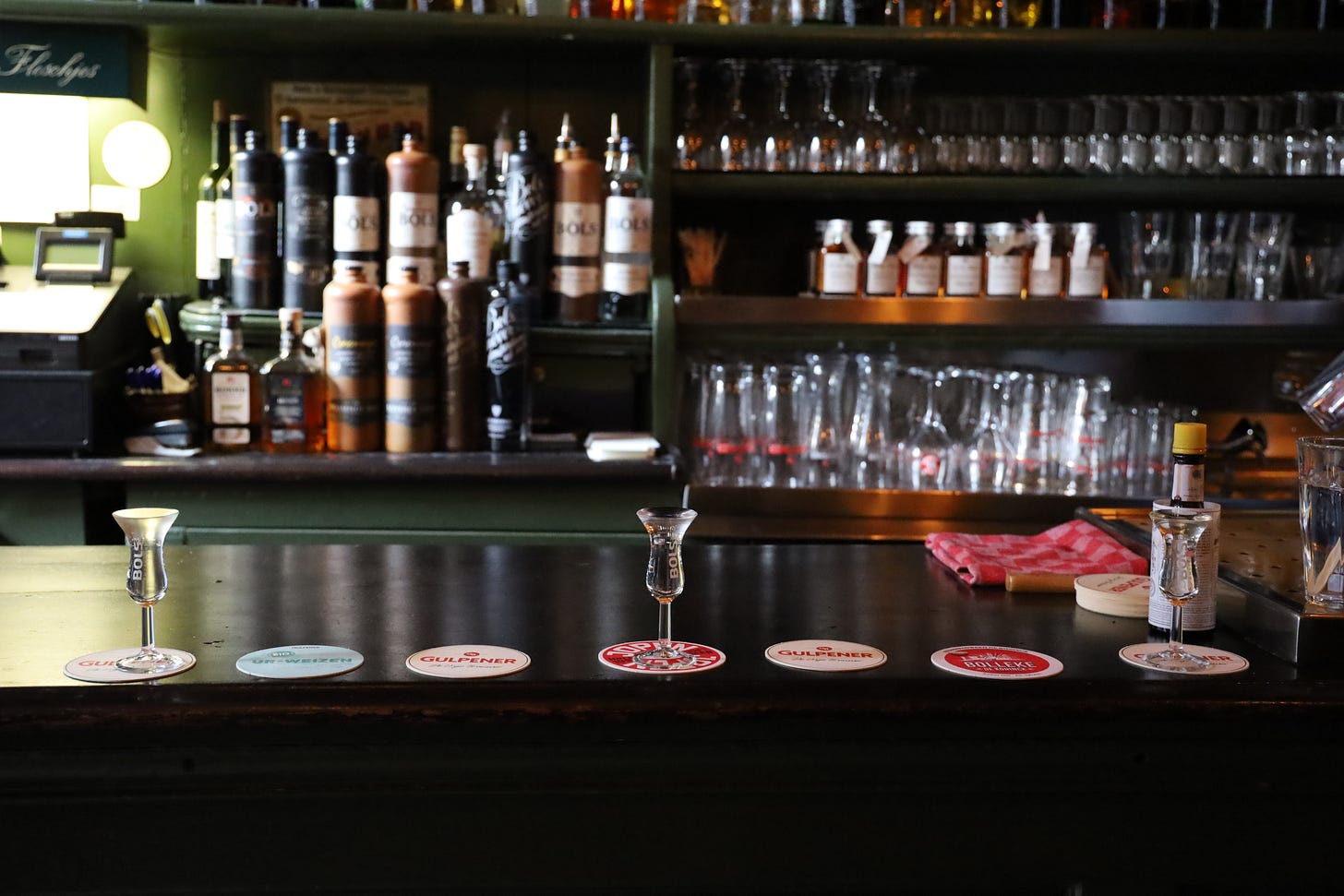Pairing the Traditional Dutch Bitterballen and Kopstootje, With Cooking Tips from Two Michelin-Starred Chef Sidney Schutte
Bring the Netherlands into your kitchen by making bitterballen with tips from Spectrum's executive chef Sidney Schutte. Plus, a tasty kopstootje recipe to pair.
I hope you enjoy my first ‘Recipe Book’ newsletter for The Tipsy Traveler! The ‘Recipe Book’ section is a place where you can find a variety of curated recipes for drinking (and some eating, too). Here you’ll find cocktail recipes for creating more complex drink ingredients such as ferments, pickles and cordials; low-waste techniques to use in both the bar and the kitchen; food and drink recipes from places I’ve traveled to, and more. The ‘Recipe Book’ is meant to inspire culinary creativity, with a little help from a world of friends in the know.
I never leave Amsterdam without eating some bitterballen — they’re the ultimate Dutch bar snack. If you’ve never had bitterballen before, they’re essentially the Dutch version of croquettes: balls of beef or veal ragu, which are coated with breadcrumbs before being deep fried and served with a side of spicy mustard. Utter filth. Pair them with a traditional kopstootje—shot of genever and a half pint of beer—and you have yourself a Dutch Happy Meal, as I like to call it.
Bitterballen originated in the mid-1900s as a way to make use of yesterday’s meat leftovers. From that point onwards, it quickly became a beloved staple of traditional Dutch cuisine. They can be found on most bar snack menus at brown cafés (i.e Dutch pubs), but hotel bars in Amsterdam are also known to make some of the best bitterballen (the ones at Bar The Tailor and Pulitzer’s Bar are worth seeking out).
Making them is fairly simple if you follow the general gist of instructions: Take some ground meat, add some herbs and aromatics (read: onions), and toss it into a roux (i.e flour and a fat mixed together to form a paste) and thicken; refrigerate to set, roll the ragu into balls, bread them, deep fry them, et voilà.
To dive even deeper, I’ve asked chef Sidney Schutte, executive chef at the Waldorf Astoria Amsterdam and its two Michelin-starred restaurant Spectrum, to share his take on bitterballen, and how to make them. For the full Dutch food and drink experience, I’ve also recommended a kopstootje to pair. You may not be able to travel to Amsterdam sometime soon, but that doesn’t mean you can’t bring a piece of Dutch culture into the home. Enjoy!
Watch for Chef Sidney Schutte’s Tips on How to Make Bitterballen:
Video credit: Monica Singleton
Bitterballen
Recipe by: Sidney Schutte
3 kg Braised veal meat (cooked)
2 L veal stock
250 g butter
375 g flour
1/2 onion (diced)
1/2 tbsp chopped thyme
1 bunch parsley (finely chopped)
1/2 bunch celery (finely chopped)
Salt and pepper (to taste)
Eggs
Panko breadcrumbs
Instructions:
In a frying pan, melt the butter, then add the diced onions followed by the flour. Cook this mixture for 3 minutes until the flour is cooked, then slowly add the veal stock and whisk. Once the base mixture reaches a smooth texture, add the meat, thyme, parsley and celery and mix together; then remove from heat.
Once the filling reaches room temperature, transfer it into a mixing bowl and cover it with cling wrap, then put it in the fridge to cool for at least 4 hours.
Once the filling thickens, it’s time to create the balls. Shape them, then set them aside on a parchment paper-lined baking tray. Dip the balls in beaten eggs, then bread with panko breadcrumbs before deep frying in oil at 180°C (356°F). Fry until golden brown, then set aside on a rack to slightly cool before eating them. You’ll most likely scald the roof of your mouth out of excitement, but don’t worry as both chef Schutte and I have been there. Enjoy!
Bols Genever & Peroni Kopstootje
Kopstootje, which means “little head-butt” in Dutch, is a drinking ritual which is mostly found in brown cafés, or Dutch pubs around the country. To enjoy a kopstootje, the bartender fills a tulip-shaped shot glass with genever (a quintessential Dutch spirit that’s somewhere in between a gin and a malt whisky for those who aren’t familiar) to the point where it almost overflows. The drinker then places their hands behind their back, bends over to bow towards the glass, and slowly sips from the top of the glass to make sure none spills when you pick it up (per why it’s called “little head-butt”).
For my recommended kopstootje, I’ve gone for a simple pairing of Peroni and Bols Genever. Yes, Peroni is Italian; but it’s also an excellent pairing and can be found in most liquor stores and shops. It’s a really straightforward kopstootje that hits the spot, especially when paired with some bitterballen. If you want to really go full-on Dutch with your beer, then Amstel or Grolsch will also do.
Recipe:
1 shot of Bols Genever, in a tulip glass, if possible (pictured below)
1 half pint of Peroni
Instructions:
The easiest pairing of all time. Pour a beer into a chilled glass, and pour a shot glass filled to the brim with genever. In traditional Dutch fashion, put your hands behind your back and bend over (no hands allowed!) to take a small sip of the genever before picking it up to avoid spilling—it should be that full—and then enjoy beer and genever at your own pace.




